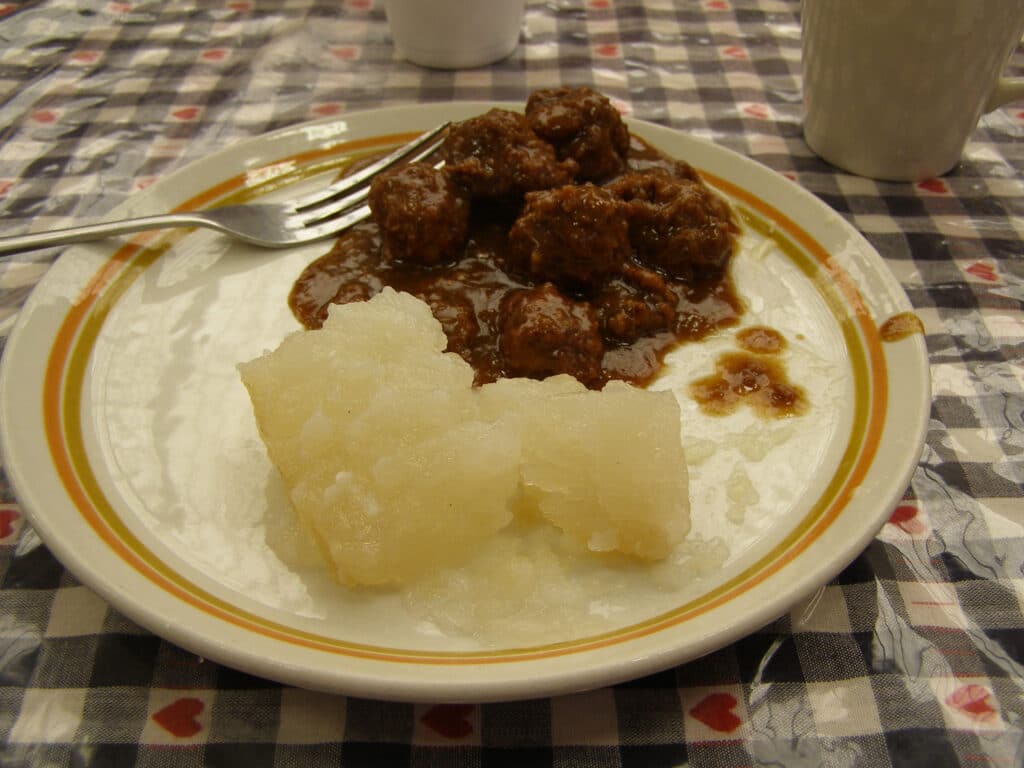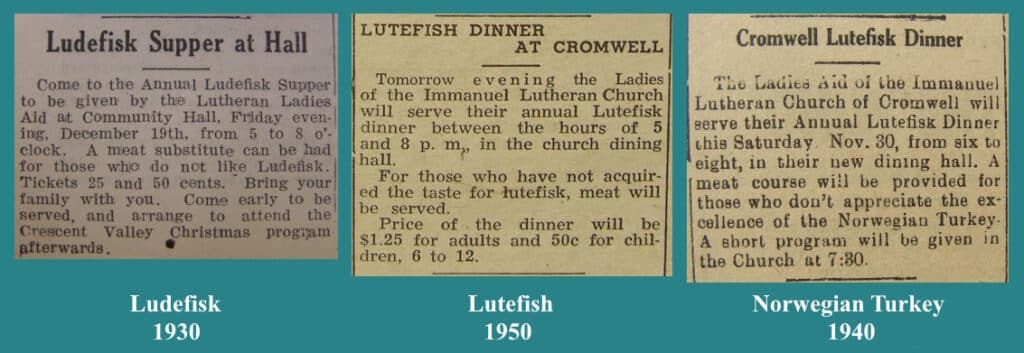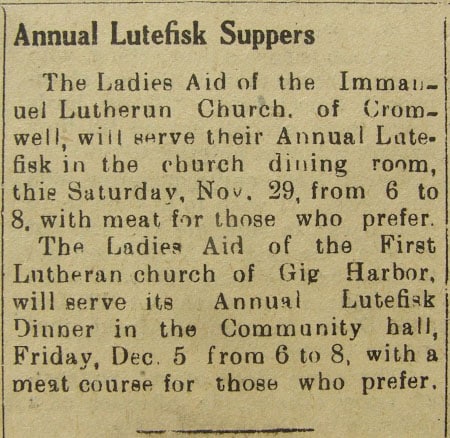Arts & Entertainment Community
Gig Harbor Now and Then | The lutefisk slander has to stop
Due to unforeseen circumstances, the column previously scheduled for this week will not be presented. That’s not a bad turn of events, for it provides the opportunity to cover a much tastier topic. It’s one that a great many Peninsulans cherished in years past, yet has tragically become mostly forgotten today.
Arts & Entertainment Sponsor
Arts & Entertainment stories are made possible in part by the Gig Harbor Film Festival, a proud sponsor of Gig Harbor Now.
Tragically to some, that is. For perhaps an overwhelming number of others (all distressingly misguided), a more accurate word might be “fortunately.”
Culinary gifts from the old country
The Gig Harbor and Key peninsula settlers of yesteryear included a nice variety of foreigners, who brought with them a wide assortment of foods and recipes from their old countries. When historians talk about the U.S. being a melting pot of peoples and cultures, food is an important part of the mix.
Sometimes immigrants to the Peninsula from a single country brought with them more than one type of cuisine. For example, the preparation of Italian food differs considerably between the south of Italy and the north. Unfortunately for the Greater Peninsula, it didn’t have first-class Italian food of either variety until Massimo Italian Bar & Grill arrived in Gig Harbor some years ago. With the establishment of Mike Simone’s IL Lucano in Massimo’s original location after he relocated to Purdy, it now has two top-notch Italian restaurants.
If it somehow seems like maybe I’m being just a little partial to Massimo and the IL Lucanno, I am not. In fact, I’m being hugely partial to both. But that’s only because they’re the best places in town. Besides, what do you expect from a guy named Spadoni?
It would seem at this point that I may have drifted a bit off topic, but the best Italian food will do that to you. It’s not universally considered to be one of the world’s two greatest cuisines for nothing, you know.
Getting to the fish of the matter
The real topic this week, however, is a certain Scandinavian food of mythic renown: lutefisk. For several Peninsula generations, lutefisk was a cherished seasonal dish of the fall and winter, served not only in Scandinavian homes, but routinely at church and school fundraisers as well. In a crime against humanity, that tradition has been lost.
Because October is the beginning of lutefisk season, there is no finer time for Gig Harbor Now and Then to sift through the rumors and innuendo concerning the Scandinavian delicacy and filter out the chaff to reveal the truth.
Tales from the lutefisk crypt
All my life, I’d heard horror stories about lutefisk, a notorious Scandinavian delicacy. (Foods are described as a delicacy only when they’re so unpalatable that an average person can eat only a small amount without throwing up.) The older I grew, the worse the stories became.
Lutefisk is indeed an easy mark for terrifying tales of culinary repugnance. The mental image of raw codfish dried for weeks, then soaked in lye for days is naturally going to be at the opposite end of the Yummy Treat spectrum from strawberry shortcake or chocolate chip mint ice cream.
And the smell. Oh, have I heard tales of the smell — or, more accurately, the stench! According to some of the lutefisk victims I had talked to, nothing fouls the air like properly prepared lutefisk. It’s bad enough to make you sick even if you don’t eat the stuff, or so I’d been told.
Well, there comes a time in everyone’s life when, at least temporarily, they either gain enormous courage or become dangerously reckless. Apparently, I reached one of those points, for I decided it was time to taste lutefisk for myself. That I lived to talk about it is probably a surprise to many, but that’s only because they’ve believed all the nonsense that has smeared the reputation of what is really a wonderful adventure in dining.
Unfortunately, the long-standing lutefisk tradition had already been lost on the Peninsula by the time I was ready to try it, forcing me to go to Kitsap County to find some.
After the first one in Bremerton, all subsequent lutefisk dinners I attended were held at Poulsbo’s First Lutheran Church. It had been hosting the annual fundraiser for nearly a hundred years by the time I discovered it. In one of life’s major disappointments, that tradition, too, now belongs to the ages. Nothing, however, can dim the fond memories of those glorious days. And now I get to share the benefit of my experience with anyone brave enough to keep reading.
Tripe will test your mettle
First off, for all you whiny, wussy, pansy asses who think lutefisk smells bad, let me clue you in: tripe smells bad, not lutefisk. Tripe, for the uninitiated, is the somewhat rubbery lining of cattle stomach that is also considered to be — surpise, surpise — a delicacy.
Compared to tripe, lutefisk is like a field of fragrant wildflowers. Tripe, for those who’ve led charmed lives never subjected to the foul odor of it cooking in a stew pot, smells like the world’s dirtiest feet trapped in the confines of a small, windowless room; toe flesh being eaten by an advanced stage of jungle rot on a tropically hot, suffocating, muggy day.
That is true stench.
Lutefisk, on the other hand, smells like fish. Not strong fish, not rotten fish, just plain old fish. At certain points of the drying/lye-soaking process it smells less than wonderful, but not when it’s cooking or served. Tripe on the stove is death by a thousand whiffs. In comparison, lutefisk doesn’t even rate.
As far as the flavor goes, lutefisk tastes like … (dramatic pause) … fish. Very mild fish. Cod is a mild fish to begin with and the process of lutefisk-isation only makes it milder. In fact, it’s so mild that it doesn’t overpower any food it’s served with.
It’s interesting to note that tripe, in spite of the deadly poison warning of its ominous cooking smell, doesn’t really have a strong flavor either, and what it does have isn’t bad at all. Maybe the toxins boil off during cooking?
However, I will concede that the texture of lutefisk might be somewhat off-putting to some. It’s very odd; soft with varying degrees of a jelly-like consistency. Not what one normally expects of fish. Try to imagine what it would feel like to take a bite of a dead jellyfish from a saltwater beach, after baking in the sun. I’m not about to test it, but my guess is that the texture is about the same.
Ultimately, despite the protestations of those who seem to have an unreasonable fear of the stuff, the ugly truth about lutefisk is that all the horror stories about it are lies!
Artery-clogging good
Not only is lutefisk not bad, but the traditional Norwegian practice of eating lutefisk with meatballs in gravy, lefse (a very tasty flat, tortilla-like potato bread), boiled potatoes, coleslaw and carrots (with some variations, depending upon the sponsor) can be quite a satisfying experience. And how can it not be? They smother everything in butter!
They have serving plates of stick butter for the lefse, and pots of melted butter for everything else. The common idea that lutefisk is terrible stuff is nothing more than a big lie, but it’s pretty certain the butter’ll kill you! There’s so much butter you can actually feel your heart struggling to pump the sludge.
Another terrific topping they serve is cinnamon sugar for the lefse. It being common knowledge that everything tastes better with butter, why not pour some on your cinnamon sugar? How about on a bowl of cinnamon sugar? As long as you don’t bring a nagging spouse with you, there are no diet police at lutefisk dinners.

When I attend a lutefisk dinner, I always make sure to get the fundamentals first — meatballs and lutefisk — just in case an unforeseen disaster (earthquake, lightning, typhoon, etc.) strikes in mid-meal. Photo by Greg Spadoni.
And as if that’s not appealing enough (it is), a traditional lutefisk dinner is all-you-can-eat!
That means if you want to gorge yourself on nothing but heaped plates of lutefisk and wash it down with a glass or two of melted butter, you’re free to do so. And, quite frankly, who wouldn’t want to, given the opportunity?

Kevin Meyer’s plate displays a normal level of dining sophistication that I do not possess. Note the half-depleted bowl of lutefisk in the upper left corner. When that was empty, servers brought us another full one. Photo by Greg Spadoni.
Every time I’ve had it, lutefisk diners are seated at a long table among many in a large room or auditorium, oftentimes with strangers if your personal group isn’t large enough to occupy every seat.
Once the meal begins, the servers, usually dressed in traditional Scandinavian garb, continue to bring freshly filled pots, pans, plates, bowls, and dishes of food, and melted butter by the gallon (OK, so maybe by the pint) until everyone at the table is thoroughly stuffed, deeply satisfied, and teetering on the edge of a cardiac event.
And then they give you ice cream!
The dessert is the only thing they don’t give you an endless supply of, but it’s not uncommon for a tablemate to be too full to partake, so sometimes you can double up by taking theirs. Of course, if you do, it’s sure sign you didn’t eat enough lutefisk. (What’s the matter with you?!)

Lutefisk, ludefisk, lutefish, Norwegian turkey: Lutefisk by any other name would taste as sweet. These clips from the Peninsula Gateway were found at the Harbor History Museum.
While the food is the draw (yum!), the dinners also offer entertainment, though not as an organized part of the event. It’s always great fun to watch first-timers at your table struggle with the idea of tasting something they’re sure will make them barf.
But it never does.
In fact, what it does do is expand your personal horizons, making you a better person.

A prime example of what made the Good Old Days so special in the Gig Harbor area was having two public lutefisk dinners in six days. Can you even imagine?! This mouthwatering clip from a 1941 Peninsula Gateway was found in the Harbor History Museum, which raises the question: When is the museum going to begin a new tradition of annual lutefisk dinners?
An innocent victim
The reputation of lutefisk has obviously been subjected to an undeserved, wildly inaccurate, mean-spirited disinformation campaign. Those who’ve fallen for it need to stop believing the false horror stories, stop being so ridiculously squeamish, and eat the damn lutefisk! It’s not going to kill you.
Nor will eating tripe, although the smell of it cooking might.
Next time
The next Gig Harbor Now and Then column will return to questions of local history. It will also disclose one more fascinating fact about cooking tripe … and if there’s a more discouraging and less appealing way to end this week’s column, I can’t imagine what it would be.
But it’s a good fact, I swear! It has the potential to bring enormous relief to the masses. Who’d want to miss that?
— Greg Spadoni, October 7, 2024
Greg Spadoni of Olalla has had more access to local history than most life-long residents. During 25 years in road construction working for the Spadoni Brothers, his first cousins, twice removed, he traveled to every corner of the Gig Harbor and Key Peninsulas, taking note of many abandoned buildings, overgrown farms, and roads that no longer had a destination. Through his current association with the Harbor History Museum in Gig Harbor as the unofficial Chief (and only) Assistant to Linda McCowen, the Museum’s primary photo archive volunteer, he regularly studies the area’s largest collection of visual history. Combined with the print history available at the Museum and online, he has uncovered countless stories of long-forgotten local people and events.

